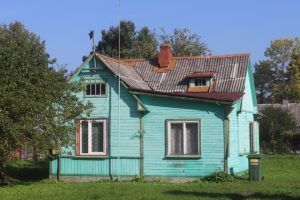After a few days city exploration it was time for some nature again. Outside Riga is the Kemeri bog, a kind of wetland resulting from the differential filling in of post-glacial valleys, which ultimately led to an area full of small lakes, called bog pools. The area is part of a national park, and has been developed to allow visitors to see the pools while keeping dry feet; I suppose it has been fairly dry recently, but the fact that the entire walk is across wooden boards suggests that most of the time this area is much wetter. The first part of the walk isn’t very exciting, but the deeper we get into the bog, the more pools appear, and without much wind they are mostly perfect mirrors for the vegetation on the edges. Grasses are extremely bright green, to yellow, mosses a dark red or brown, a fabulous colour scheme. The best comes at the far end of the board walk, where we climb a viewing tower that provides the same scenery, but from higher up, bog pools as far as the eye can see. Breathtaking!
We didn’t expect much from Kemeri village, except a cup of coffee. But like every village in this part of the world, it is like an open air museum. The Saint Peter-Paul Orthodox church is made of wood, entirely, and stems from 1893. And is part of a lovely park. But far more enchanting are the wooden houses – there they are again; we are just not used to this, but wood is everywhere, especially in construction. The only thing lacking was a coffee bar.
The next national park is around the Engure Lake, further west, and once again equipped with a viewing tower at the end of a trail. Although famous for its birds, we got there mid-afternoon, not the best time for birds; we spotted a woodpecker, some herons, some sea gulls and a duck or two, but the most obviously present animals were some semi-wild horses that didn’t look particularly wild.
Having been driving along the north coast for some time, without actually seeing the sea – the area along the beach is all privately developed -, we finally managed to get to the beach in Mersrags, near its lighthouse. The cast-iron lighthouse itself was not so spectacular, but the wooden church, a little further inland, was lovely, and especially the extremely well kept cemetery behind the church impressive. Altogether, a change of scenery from the city.
Next: Kuldiga.


































